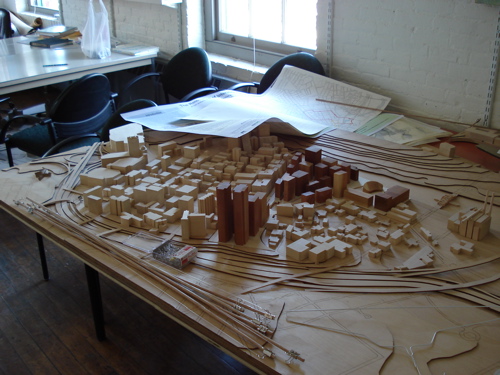Yesterday I spent the day in Providence at the Rhode Island School of Design, where I gave a talk in Anne Tate’s course “American Communities in the 20th Century: Civics and Sustainability.” She was interested in having me present some of my dissertation research and make connections between community planning and online technologies. It was good to have a live audience to help me think through my project in fresh ways, and gearing it toward future architects and planners forced me to clarify what claims I was qualified to make. The title of my talk, “Placemaking in a Digital World,” seems overblown in hindsight, since my goal was simply to provide a bit of context for our discussion of how the web might be used to strengthen towns and cities (their final project is to create plans for revitalizing urban communities). But the discussion seemed fruitful, and I enjoyed the chance to observe how learning happens in a design setting like RISD.
This photo of Anne’s office shows a model of Providence that represents the downtown area which will be freed up for development as a result of the I-195 re-rerouting project (Providence’s version of the Big Dig).

Selected Resources
Books
Kotkin, Joel. The New Geography: How the Digital Revolution Is Reshaping the American Landscape. 1st ed. New York: Random House, 2000.
Holmes, David. Virtual Globalization: Virtual Spaces/Tourist Spaces. Routledge 2001.
McCullough, Malcolm. Digital Ground: Architecture, Pervasive Computing, and Environmental Knowing. Cambridge, Mass.: MIT Press, 2004.
Mitchell, William J. City of Bits: Space, Place, and the Infobahn. Cambridge, Mass.: MIT Press, 1995.
—. Me++: The Cyborg Self and the Networked City. Cambridge, Mass.: MIT Press, 2003.
—. Placing Words: Symbols, Space, and the City. Cambridge, Mass.: MIT Press, 2005.
The Internet and Local Communities
Locative Media
Place Blogging
- Ecotone: Blogging About Place
- Fragments from Floyd
- “Blogging Places: Locating Pedagogy in the Whereness of Weblogs.” Kairos: A Journal of Rhetoric, Technology, and Pedagogy. 10:1 (Fall 2005).

Comments